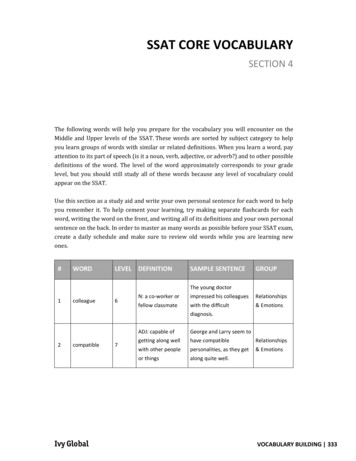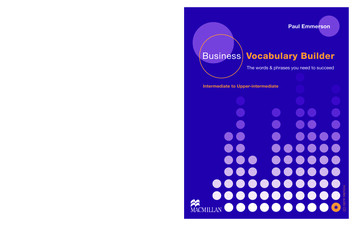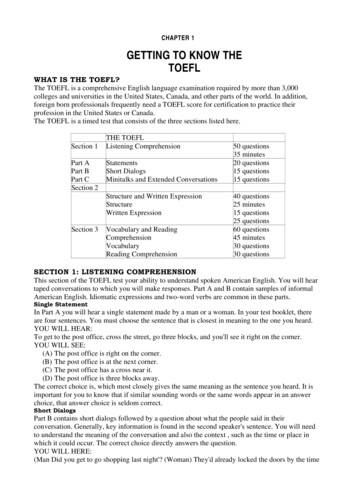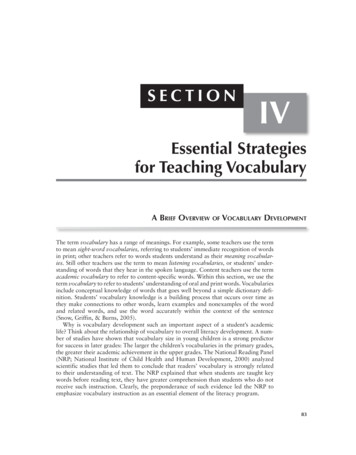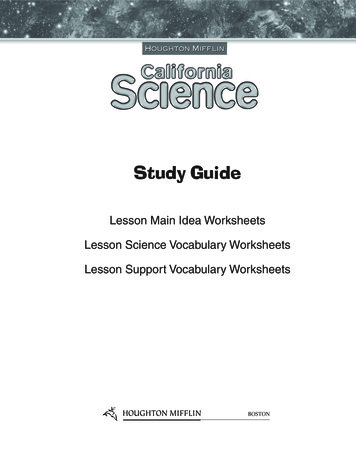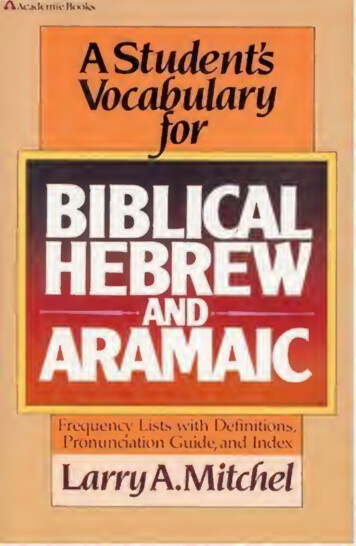
Transcription
BIBLICALEFrequency Lists with Definitions,Pronunciation Guide,and IndexLarry AMitcfiel
mwmIjBLICALHEBREWI—- AND-—ARAMAICUmy A.MitcfielZondervanPublishingHouseGrand Rapids, MichiganA Division o/HarperCoIlins/WijAen
To Leona Glidden Running for whomRequests for information should be addressed to:Zondervan Publishing HouseGrand Rapids, Michigan 49530Library of Congress Cataloging in Publication DataMitchel, Larry A.A student’s vocabulary for biblical Hebrew and Aramaic.Bibliography: p.Includes index.1. Hebrew language—Wordfrequency.2. Hebrew language—Glossaries, vocabularies, etc.3. Aramaic language—Glossaries, vocabularies, etc.4. Bible.O.T.Language, style.I. Title.PJ4845.M5 1984221.4*484-5219ISBN 0-310-45461-1miar'r8e,ner“ rIy1,em0 oT, felectronic. mechSPUblicati0" y be -produced, s.orany form or b means-brief quotations in primed renewspublisher.’Printed in the United States of America00 01 02 / DH / 22 21 20 tberr exceP' fprior permission of tlSemitic languages are a consuming andcontagious interest.
CONTENTSPREFACEHOW TO USE THIS STUDENT’S VOCABULARYBIBLIOGRAPHYTABLE OF VALUESABBREVIATIONS AND SYMBOLSixxiiixviiixxixxiiiSECTION 1: HEBREW WORDS OCCURRING MORE THAN 500TIMESISECTION 2: HEBREW WORDS OCCURRING 500 - 200 TIMES4SECTION 3: HEBREW WORDS OCCURRING 199 - 100 TIMES8SECTION 4: HEBREW WORDS OCCURRING 99 - 50 TIMES14SECTION 5: HEBREW WORDS OCCURRING 49 - 10 TIMES23SECTION 6: ARAMAIC VOCABULARYINDEX5266
PREFACEPurpose of this Student’s VocabularyIn light of the availability of a number of Hebrew vocabulary lists, it isproper to ask why another such list should be put in print. The volumes thatfirst come to mind each make a real contribution. George M. Landes’s AStudent’s Vocabulary of Biblical Hebrew has an obvious advantage in itsgrouping of Hebrew words by root, a helpful aid in learning vocabulary. TheHebrew Vocabularies of J. Barton Payne present the Hebrew particles in aparticularly helpful way. And the small volume by John D. W. Watts (Listsof Words Occurring Frequently in the Hebrew Bible.), which like Payne’s isbased on William Rainey Harper’s Hebrew Vocabularies (published in 1890),presents Hebrew vocabulary down to 25 occurrences in a very compact form.However, in my experience in teaching biblical Hebrew on the undergradu ate level, I have felt that each of the above excellent works have presented twofundamental problems for entry-level Hebrew students: (1) each volume incor porates a number of separate lists, requiring reference to various parts of thebook in order to find all Hebrew words of a given frequency; and (2) the liststhemselves are apparently set by somewhat arbitrary word-frequency limits,resulting in lists of greatly variable length. The present work seeks to remedyboth of those basic problems.The lexicon of Old Testament Hebrew contains some 10,000 words in all.Of these, approximately 740 occur fifty times or more. A full 490 occur ashapax legomena by Harold R. Cohen’s definition (see volume in Bibliography;pages xv and 6-7). Many more words in the MT occur only once, though otheroccurrences of that same Hebrew root may also appear.The Aramaic lexicon consists of approximately 650 words. Since theamount of Aramaic text in the OT is so much less than that of Hebrew text,the number of occurrences of Aramaic words is lower.For the Hebrew vocabulary sections (Sections 1-5) an attempt has beenmade to include every word that occurs ten times or more. The one exceptionto this inclusive statement has to do with proper nouns: only those personaland place names that are used fifty times or more are included. The primaryreason for including proper nouns at all is that while some Hebrew place namesand personal names are reasonably “transparent” to students familiar with theOT in English translation, many are rather “opaque.” This is the case becausethe English transliteration that the student knows often reflects Greek formsmore than the original Hebrew name. For examples of the latter, see Isaac(Section 3.F), or “Solomon” (2.C).
xPrefaceA section containing Hebrew words occurring less than ten times was.prepared for this project. Simply for considerations of length it has not beenincluded in this volume. (It was twice as long as Sections 1-4, both in numberof entries and estimated page length!) Most Hebrew students would probablyfind little use for this section of Hebrew vocabulary.In the case of the Aramaic vocabulary (Section 6), the effort has been madeto include every Aramaic word, except for proper nouns. (No personal or placenames have been included, except for a few that occur more than fifty timesin Aramaic and Hebrew and thus are listed in Sections 1-4 with a noteregarding the number of occurrences in Aramaic.)A glance at the Table of Contents and the first few vocabulary lists shouldbe enough to clarify the arrangement of this volume. Instead of juggling twoor three (or more) different frequency lists, all words of a given frequencyrange have been gathered into one list. By learning one list (or series of lists)-—not two or three— a student can master all Hebrew (or Aramaic) words in thatfrequency range. Vocabulary learning effort can thus be better focused.Furthermore, instead of setting arbitrary frequency ranges, this Student’sVocabularyt has had as its priority the production of consistently short, man ageable lists. In general, this means lists not in excess of thirty words. Thisideal holds true until sheer numbers of words of identical frequency makesmaller lists impossible, short of artificially breaking up longer lists alphabeti cally. (You can’t have words that occur between 1.5 and 1.2 times in the MT!)By these two devices then, combining all MT vocabulary into one sequenceof lists containing less and less frequently-occurring words, and adjustingfrequency ranges to keep lists reasonably short, this Student’s Vocabulary hassought to meet the pedagogical shortcomings of other available Hebrewvocabularies.Resources for the Preparation of A Student's VocabularyA number of reference works have been used in the determination of wordfrequencies. Trial lists were prepared based on frequencies given by Landesand Payne. However, all the words included in this vocabulary have beenindependently checked— except where the number of occurrences obviouslyexceed 5000-— by an actual count. The primary reference works have beenthe concordances by Lisowsky and Mandelkem. Additionally, occasionalreference has been made to Wigram’s Englishman’s Hebrew and ChaldeeConcordance. Consult the Bibliography for publication details.AcknowledgementsWithout the help and encouragement of a large number of people thisvolume would not have been produced. In particular I think of two of mystudents at Pacific Union College, Larry Errett and Cathemae Cecchin. LarryErrett, an able linguist, did some of the earliest work on word counts, espe cially in the highest frequencies. And Cathe Cecchin, who worked as myPrefacexisecretary for three years during her undergraduate study, has nearly singlehandedly accomplished the staggering task of entering encoded text destinedto be translated by computer into printed and pointed Hebrew script and (atthe cost of even more effort) phonetic spellings.W. Larry Richards, Religion Department chairman during the more criticalstages of research for this volume, provided much-needed encouragement, butalso the sorts of scheduling concessions without which this entire project mightwell have foundered. Small academic institutions seldom have adequate re search-support resources. However, the administration of Pacific Union Col lege has been most helpful and cooperative, supplying both the funds forstudent assistants and the resources and expertise of the College computerfacility.For computer aid and expertise, Harold E. Hunt and Bernard Maron ofAutographies, Inc., in Monterey Park, California, richly deserve praise. It wastheir work that helped turn a concept into reality, and this even though all toooften my idea of how to reach reality represented rather different ways of doingthings. And here at Pacific Union College, our work of data entry was madeimmeasurably easier, and therefore more accurate and less time-consuming,by the efforts of Dr. Gilbert Muth, chairman of the Biology Department, a manwho writes elegant computer programs that work (no mean feat!).And finally, to my wife Carola, and to Carmie and Jason, I owe a large debtfor constant support and understanding. Work on this project has consumedtime that would have otherwise been theirs.While every reasonable effort has been made to reduce errors to an absoluteminimum, it is virtually certain a few such will remain. I would welcome anynotices for corrections or improvements. Send these either directly to me orto the publisher.Learning Hebrew vocabulary requires a lot of time and effort. I hope thisvolume will help both instructors and students of biblical Hebrew and Aramaicto make the most efficient use possible of their vocabulary study time.Larry A. MitchelPacific Union CollegeAngwin, California 94508December 1983
HOW TO USE THIS STUDENTS VOCABULARYGeneral OrientationThe purpose of vocabulary study is to learn the correct spelling, pronuncia tion, and meaning of a set of new (foreign or native) words. Since correctpronunciation of Hebrew words is an integral part of effective vocabularylearning, the student should from the beginning take seriously the matter ofconsonant and vowel values in Hebrew. For convenience a Table of Valueshas been provided for reference. However, these values will simply have tobe committed to memory before efficient study of Hebrew vocabulary canbegin.Beyond the phonetic value of the Hebrew consonants and vowels them selves, Hebrew pronunciation is also determined by several other interrelatedfactors:(1) Syllable division. Hebrew syllables may be either “open” (consistingof a consonant followed by a vowel) or “closed” (a consonant, a vowel, anda consonant— in that order). For the rules governing the use of long or shortvowels (and non-vowels) in a Hebrew word, the student should consult his/her grammar. (The “half-open syllables” are discussed below under “Phonet ic Spelling.”)(2) Use of szwa. Pronunciation of Hebrew words also depends upon adetermination as to whether the “non-vowel” sowa is “vocal” (stands underthe opening consonant of a syllable) or “silent” (under the closing consonantof a syllable).(3) Accent. The placement of the stress in a Hebrew word can materiallyaffect its pronunciation. This is especially obvious when the form of a wordchanges, for example in the formation of a plural or the addition of suffixes.In this vocabulary, accent marks are only used for multi-syllable Hebrewwords that are stressed on other than the final syllable. The mark is used.(4) Furtivepdtah. Some Hebrew words that end in guttural-letters (especiallyn and y) must be treated uniquely in pronunciation. Though the final consonanthas a pdtah under it, the vowel is pronounced before the consonant. Note thatfurtive pdtah is written in phonetic spelling as a raised a (a). The commonpractice, observed herein, is not to show a syllable division in phonetic spellingfor furtive pdtah. Contrary to the practice of some grammars and lexicons, inthis vocabulary the Hebrew forms show the accent mark. (Example: SPp'l,ra/qK.)Because of these and other variables, it was decided to include in this
How to Use This Student’s Vocabularyxivvocabulary a phonetic rendition (transliteration) of each form presented. Incases where more than one Semitic form is involved, transliterations are givenin the same order as the Hebrew (or Aramaic) words. Syllable divisions andstress accents are also indicated.Beyond proper spelling and pronunciation, the student needs to leam themeaning of the Hebrew words he/she is studying. The definitions that havebeen provided in this volume are basically correct, and have been chosen inconsultation with standard Hebrew lexicons (particularly William L. Holladay’s A Concise Hebrew and Aramaic Lexicon of the Old Testament.). Thesemeanings are in no sense full and exhaustive. For the meanings of nouns invarious contexts, or of verbs in different contexts or in derived conjugationstems, the student must consult a trustworthy dictionary or lexicon. See theBibliography for a number of helpful and reliable lexicons and dictionaries.Individual language teachers may wish for whatever reason to supplement oremphasize (and even in some cases supplant) given definitions. But in generalthe meanings given for the Hebrew words in this vocabulary have been chosenwith the beginning student in mind, and do provide base meanings that willserve those needs.This Student's Vocabulary’ can be used to great advantage along with AReader's Hebrew-English Lexicon of the Old Testament by Armstrong, Busby,and Carr. By simply learning the Hebrew vocabulary down to fifty occur rences, about 739 words in all, a student should be able to read plain Hebrewtext by following along in the appropriate section of the Reader's Lexicon, andreferring there for all forms which occur less than fifty times (assuming aminimum knowledge of grammar and syntax).Sample Entry and ExplanationPerhaps the best way to explain how the individual vocabulary entries in thisvolume are presented is to give examples and provide some detailed explana tions. The following entries are in no way complete and exhaustive, but whatthey do not contain can be easily described.(Pi)2 seek3 [ba/qaS*]4 22s5(II)6 m (prep)2 with, beside [ et] 500051 Hebrew/Aramaic Words. An attempt has been made to use forms andspellings that are favored today. In making such choices, personal judgmentsare inevitable. Not all decisions may seem to every trained reader to be thebest ones. Hopefully no decision \tfill mislead the beginning student. One suchjudgment relates to Hebrew and Aramaic words spelled with a long “o ” Invery many cases the word appears in the MT spelled with both “defectiveh6lem ( 0) and WIth “ful) holem" (i, 6). This vocabulary has not achievedconsistency on the matter: if you can not find a word under one spelling trythe alternate spelling before giving up! (The same goes for full and defectivespellings with— and without— yod.)ixvHow to Use This Student’s Vocabularya. Verbs: unpronounceable words are more difficult to to learn— at least ifthe ear helps at all in vocabulary study. For this reason all verb roots have beenprovided with vowels. In the case of verbs that only occur in non-Qal stems(and are thus left unpointed in most lexicons), this Student's Vocabulary givesto the root those vowels that pertain to the (missing) Qal form. Since this formis hypothetical, an asterisk (*) is placed after the entry. This practice has alsobeen observed for the so-called hollow verbs (verbs with a yod or waw in thesecond position), even though the verb may in fact appear in just that form.(This has been done because there is often uncertainty, and some disagree ment, regarding the appropriate vowel.) Furthermore, in many cases the verb,though used in the Qal, may not occur in the third masculine singular eventhough the asterisk is missing.b. Nouns, adjectives, prepositions: an asterisk after these forms signals thatwhile this is the dictionary form of the word, for one reason or another theword never appears just this way in the MT. (As a rule, simple changes inform, such as the addition of a suffixed pronoun or the construct state havenot been listed in this vocabulary with an asterisk.) An explanation of thereason for the asterisk is provided in the definition section.c. General comments: the names of ancient Near Eastern countries and theirrespective gentilic (people-naming) nouns have been combined in single en tries, and listed according to total number of occurrences.Numerals have also been gathered into single entries, corresponding wordsfor multiples of ten (“twenty,” “thirty,” etc.) being given under the Hebrewword for that number. Numbers from three to ten are identified by the genderof the form. (In that range Hebrew uses feminine numerals for masculinenouns, and vice versa— a device called “chiastic concord” in some gram mars).Occasionally, particularly for words of low frequency, there is considerableuncertainty even regarding a hypothetical vowel-point assignment. In suchcases the Semitic word is followed by a question mark in parentheses (?).Defective hblem can be located in a variety of places over a Hebrew word.The practice of placing this vowel point toward the left margin of widerHebrew consonants has been followed herein, as well as the practice of notdouble-dotting sin when it is preceeded by defective holem. Defective holempreceeding blep is commonly written over the right margin of the latter, andhas been written that way in this volume.2 Grammar/Morphology: information of importance or convenience abouta word’s part of speech, conjugation stem, or person/gender/number is givenin abbreviated form preceding the definitions. The meaning of these abbrevia tions may be found in the list of Abbreviations and Symbols.In the case of verbs that do not appear in the MT in the Qal stem, the Hebrewform appears in this vocabulary with an asterisk (as mentioned above). Thenote in parentheses at the beginning of the definition section then indicates the
How to Use This Student's Vocabularyxvimost commonly-used (or the simplest) derived-conjugation stem in which thatverb does occur.In;the case of nouns, adjectives, prepositions, and such, the note in paren theses identifies the part of speech and/or the reason why the asterisk has beenused.3 Word Meaning: levels of difference in the meanings for a given word havebeen indicated by separating punctuation marks: a comma divides words whichare more or less synonymous, whereas a semicolon sets off extended meaningsor rather different definitions. Roman numerals in parentheses refer to one oftwo or more roots with an identical spelling in Hebrew/Aramaic. These desig nations follow Holladay’s lexicon. Definitions are of the Semitic word as given(not, for example, in plural, even if the asterisk means that this word onlyoccurs in the plural form).Cross references in the vocabulary are identified by Section number andSubsection letter (Example: Cf l.D).4 Phonetic Spelling: as an aid to self-study, each entry includes a phoneticspelling. Beginning students should find this feature to be helpful as they beginto learn Semitic vocabulary, since it will aid in correct pronunciation ofHebrew/Aramaic words, thus enlisting the ear as well in vocabulary learning.It will be necessary to learn the proper values for each symbol from the Tableof Values. Syllables are separated by slashes (/). Accented syllables have beenindicated, except for mono-syllabic words.“Half-open syllables’’ are neither open nor closed. Such syllables appearto defy syllable-formation rules in that they contain a short vowel, are unac cented, but stand without a closing consonant. Printed Hebrew Bibles com monly use a meteg to mark these syllables (a short verticle mark just to theleft of the vowel point). Lexicons vary in their treatment of half-open syllables.In this volume those few such syllables are not marked in the Hebrew word.Rather, in the phonetic spelling the syllable is followed by an exclamationpoint (Example: Hinya, ma!/ara/ka).Number of Occurrences: counts for Hebrew words are inclusive and forthat reason somewhat overlapping. This means, for example, that a Qal activeparticiple may be counted among the occurrences of the verb, and countedagain when used as a noun. Such situations are limited primarily to wordswhich occur often enough as substantives to justify also treating them as avocabulary entry in their own right. In the case of Qal participles, only thoseoccunng ten times or more have been listed in their own entries.Commonly, word counts include forms of the word that have been prefixed(by the article or prepositions), pluralized, and/or suffixed (by pronouns) Insome situations in which such forms have become standardized (and arenumerous), prefixed or suffixed forms are listed in separate entries For verbs0jnS?etcThTMCSn0t Ihe imP'iedindiCated Verbal{Qal,Hip il, etc.), but allstemsin whichthat verb rappears.xviiHow to Use This Student’s VocabularyWord counts from Lisowsky’s concordance include Qdre readings as wellas normal occurrences. With proper nouns (where given), all occurrences ofa given name are included, even though in many cases more than one referentis intended.In cases where Mandelkem and Lisowsky disagree as to number of occur rences, the general practice has been to enter the higher of the counts, unlessfurther work (sometimes including entry-by-entry comparisons) has made itclear the lower number is to be preferred.Words identified as occurring 5000 times occur more than 5000 times; noattempt has been made to precisely establish the occurrences of these twelveHebrew words.6 Root Number: as indicated earlier, root designations follow Holladay’slexicon. In some cases several roots have been combined, for one reason oranother, into one entry. In such situations the meanings of the various rootshave been designated within the definition section.Suggestions for Using this Student’s VocabularyAs has been widely acknowledged, learning vocabulary and retaining it areprobably the most challenging aspects of learning Hebrew or Aramaic. In myexperience the principal reason for this fact is that, in contrast to New Testa ment Greek, Old Testament Hebrew and Aramaic have virtually no cognatewords in English. This requires much more rote memorization, or the forma tion of idiosyncratic memory devices. While each student must determine whatworks best for vocabulary study, here are a few common sense suggestions:(1) Flash cards. While not all language students use them, home-made flashcards provide several advantages in vocabulary learning. First, you must gothrough the motions of writing the foreign word and its definition. Second,punched and carded on a ring holder, flash cards are very transportable forstudy at odd times and in many places. Third, flash cards can be (and probablyshould be) rearranged as you learn words, so that less time is spent on wordsthat only need to be reviewed while more effort is concentrated on new orrecalcitrant forms.(2) Oral repetition. Repeating Hebrew and Aramaic words and their mean ings out loud over and over (correctly!) introduces two critical factors into yourvocabulary learning— pronunciation and hearing.(3) Repeated writing. Used alone and in connection with oral repetition,repeated writing of OT vocabulary helps to establish a memory pattern.Given the descending-frequency scheme with which this volume is pre pared, a student can develop a Hebrew or Aramaic vocabulary as far as isnecessary or desired (within the limits of this vocabulary volume). Within theranges covered herein, by using the Index and referring to the appropriateSection/ Subsection location, the number of times a given word occurs in theOT can be determined.
xvcBibliographyWigram, George V. The Englishman’s Hebrew and Chaldee Concordance ofthe Old Testament. Fourth edition. London: Samuel Baester & Sons,1843.Young, Robert. Analytical Concordance to the Bible. New York: Funk &Wagnails, n.d.BIBLIOGRAPHYArmstrong, Terry A.; Busby, Douglas S.; and Carr, Cyril F. A Reader’sHebrew-English Lexicon of the Old Testament. Vol. I: GenesisDeuteronomy. Grand Rapids: Zondervan, 1980.Vol, II: Joshua - 2 Kings (1982).Vol. Ill: Announced.Brown, Francis; Driver, S. R.; and Briggs, Charles A. A Hebrew and EnglishLexicon of the Old Testament. Oxford: Clarendon Press, 1907.Cohen, Harold R. (Chaim). Biblical Hapax Legomena in the Light of Akkadianand Ugaritic. SBL Dissertation Series, 37. Missoula: Scholars Press,1978.Feyerabend, Karl. Langenscheidt’s Pocket Hebrew Dictionary to the OldTestament. New York: Barnes & Noble, 1961.Fohrer, Georg. Hebrew and Aramaic Dictionary of the Old Testament. Trans,by W. Johnstone. Berlin: Walter de Gryter, 1971.Holladay, William L. A Concise Hebrew and Aramaic Lexicon of the OldTestament. Grand Rapids: Eerdmans, 1971; sixth impression, January1982.7Koehler, Ludwig and Baumgartner, Walter, editors. Lexicon in Veteris Tes tament Libros. One volume with Supplement. Leiden: Brill, 1958.-Hebraisches und aramaisches Lexicon zum alten Testament.Third edition. Parts I and II. Leiden: Brill, 1967, 1974.Lambdin, Thomas. Introduction to Biblical Hebrew. New York: Scribner’s,Landes, George M. A Student’s Vocabulary of Biblical Hebrew. Listed According to Frequency and Cognate. New York: Scribner’s, 1961.Lisowsky, Gerhard. Konkordanz zum Hebrdischen alten Testament. Secondedition. Stuttgart: Deutsche Bibelgesellschaft, 1958.Mandelkem, Solomom Veteris Testament Concordantiae Hebraicae atqueLhaldaicae. Third edition. Jerusalem: Schocken, 1967.—-- Veteris Testament Concordantiae Hebraicae atque Chaldaicae. Seventh edition, augmented and revised by F. Margolin and MGottstein. Jerusalem: Shocken, 1967.5Payne, J. Barton. Hebrew Vocabularies. Based on Harper's Hebrew Vocabulanes. Grand Rapids: Baker, 1956,WattScpJ h Hv ' LiS'S f WZdS ?ccurrinS frequently in the Hebrew Bible.Second edition. Leiden: Bnll, 1967
TABLE OF VALUESNOTE: Protocols adopted here are essentially those of Thomas Lambdin(Introduction to Biblical Hebrew. New York: Scribner’s, 1971; pages XXIIXXIII.) See also G. Johannes Botterweck and Helmer Ringgren, eds. Theolog ical Dictionary of the Old Testament. Vol. I. Grand Rapids: Eerdmans, 1974;page XX.TransliterationPronunciationSymbol (Name)ValueGuidelinesConsonantsN ( alep)(glottal stop—none)2 (bet)bb as in “best”v as in “vest”2bgas in “give”a (gimel)gthroatygh*idasin“day”d*T (dalet)th as in “the one”1dh as in “hay”hn (he)w as in “well”w1 (waw)z as in “zero”zT (zayin)ch as in Scots lochhn (he[)or German bucht as in “time”t0 (tet)y as in “yes”* (yod)yk as in “key”k3 (kap)ch as in German Bach3kch as in German Bachk(final form)/ as in “look”1(lamed)m as in “more”mD (mem)m as in “more”m (final form)n as in “now”nJ (nun)n as in “now”n1 (final form)5 as in “say”sD (sarnek)f(glottal stop—none)V (ayin)pas in “pay”D (peh)P
xxiiTable of Values(final form)X Qadth)f (final form)*\P (qop)1 (ref)(sin)PP§§qritT (sin)§FI (taw)ttn/ as in “face”/as in “face”ts as in “sits”ts as in “sits”harder than c in “r as in “ran”s as in “say”sh as in “show”t as in “try”th as in “thin ”Vowels and DiphthongsnTV (htreq-yod)*. ( tre-ydd)1 (full hblem)(defective hblem)1 (Mreq)T (qhme ). ( ere). (hfreq). (ttgol). (patah)T (qbmej-ha(up)s (qibbu )(furtive patah), (simple sswa)(ha(ep-patah)„ (hatep-sdgof)« (hatep-qbme ) %FrFaie60uaeiea0uraised a05a6aiaiey1.SHroy, oyuyawawiwV, V.ew, ew,!1Ta as in “father”i as in “machine”ey as in “they”o as in “note”o as in “note”u as in “flute”a as in “father”ey as in “they”i as in “pin”e as in “let”a as in “that”o as in “top”u as in “bull”a as in “account”a as in “about”a as in “about”a as in “about”a as in “about”ay as in “say”i as in “sigh”ey as in “they”oy as in “toy”uey as in “gluey”ow as in “how”ow as in “prow”ue as in “hue”av as in “save”ABBREVIATIONS AND Hithpaabsoluteactiveadjectiveadverbadversative (conjunction)alwayscommon (gender)compare, see also; seeinsteadconjecture; conjecturalcollectivecomparison; l); in ydualemphatic (Aramaic)by extension; extendedmeaningfemininefractional (number)gentilic (noun)Hap el (Aramaic)Hip ilHistap elHitpael (Hebrew);Hitpe'el (Aramaic)Hitjjaal alidiom; artpasspersPePiPilPilppiPopoetPolKotib (what is written inMT)masculineMasoretic Textmetaphorical ly)nounnegativeNip'alordinal (number)Pd el (Aramaic)participlepassiveperson(al)Pe al (Aramaic)PielPilelPilpelpluralPoelpoetic; in poetryPdlei, Po'lal
xxivAbbreviations and txt )prepositionprobablePulalQdre (what should beread in etext(ual) corrupt(ion)uncertainunexplainedverbvocativeword play*!?(?)tt§hypothethical form (assuch does not occur inMT)indicates half-opensyllableindicates uncertaintyregarding definitionindicates uncertaintyregarding Semiticvowel(s)indicates Aramaiccognate spelled like aHebrew word1. A-BSECTION 1: HEBREW WORDS OCCURRING MORE THAN 500TIMES (106)A. Words Occurring More Than 2200 Times (25)*7 (prep) unto, toward[el] 5000(II) D’H X God [’eio/hlm] 2706rp ,3’ ;mn (full; short form) TheLord [K “Yahweh”?; Q’ido/n i; ya]5766(I) *1ftX say [’a/m r] sooo fearth [e/re ] 2498(rel pr) who, which,that [*S5dr] 5000indicates Aramaiccognate with differentvowels from Hebrewindicates Aramaiccognate spelleddifferently butrecognizably(I) DV day [yom] 2241*7X*lt ' Israel [yi /ra/’61] 2513'3 (pref prep) as, like5000(I) DX (accusative particle;definite objectmarker; not trans lated) [ et] 5000(II) ’3 (conj) because, for,that, when, but;indeed, truly [ki](II) nx (prep) with, beside[ et] sooo 13, *73 all, every [kol, kol]43955000'3 (pref prep) in 5000'*7 (pref prep) to, toward(I) ; (voc) Do! Yes!(II) 5000X (neg) no, not [16’]Xl3 go in, enter, come[bo ] 2530(I) ]3 son [ben] 4887"H (pref def art) the(with dag&s infollowing cons) 5000*3 (pref interr particle)50004973(I)(II) *73 (prep) on, upon,against, over fal]4898rpn be, happen, become[ha/ya] 3514do, make; (Pi) press,squeeze (II?) fa/Sjf]"1 (pref conj) and, also,even soooB.2573Words Occurring between 2199 and 1000 Times (27)3X father [*ab] 1568(I)king [m /lek] 2522;W'X (s; pi) man [IS;’ana/S
In light of the availability of a number of Hebrew vocabulary lists, it is proper to ask why another such list should be put in print. The volumes that first come to mind each make a real contribution. George M. Landes’s A Student’s Vocabulary of Biblica
